Coastal Plain Cooter
Pseudemys concinna floridana
Common Name: |
Coastal Plain Cooter |
Scientific Name: |
Pseudemys concinna floridana |
Etymology: |
|
Genus: |
Pseudemys is derived from the Greek word pseudes which means "false" and emys which means "turtle". |
Species: |
concinna is derived from the Latin word concinnus meaning "well arranged or beautiful". |
Subspecies: |
floridana indicates the state of Florida. |
Average Length: |
|
Virginia Record Length: |
|
Record length: |
Systematics: This species was first described as Testudo floridana by John LeConte in 1829 from a specimen from the "St. John's River of east Florida." Baur (1893) first used the genus Pseudemys for this species. Chrysemys has been used for this species in the Virginia literature by Brittle (1969), Hardy (1972), Musick (1972), Mitchell (1976a), Delzell (1979), and Tobey (1985). See "Systematics" in the P. concinna account for a discussion of the generic name. The name P. concinna floridana has also been used (Virginia Herpetological Survey, 1968).
This subspecies was formerly recognized as Pseudemys floridana floridana, but Seidel (1994, Chelon. Conserv. Biol. 1: 117–130) transferred it to Pseudemys concinna. Jackson (1995, Chelon. Conserv. Biol. 1: 329–333) objected to this based on observations that concinna and floridana are sympatric in northern Florida and South Carolina. Seidel (1995, Chelon. Conserv. Biol. 1: 333–336) countered that the two forms may be macrosympatric at some locations, but that they intergrade in other areas. Based on morphometric, osteological, biochemical, and pigmentation studies, Seidel (1994, Chelon. Conserv. Biol. 1: 117–130) found no character which reliably separates the two forms in many transition areas (intergrade zones) between the coastal plain and piedmont of the Atlantic slope. However, the two forms are microsympatic throughout the panhandle of Florida (Meylan, 2006, Chelon. Res. Monogr. 3: 28–36). Jackson (2006, Chelon. Res. Monogr. 3: 325–337), Thomas and Jansen (2006, Chelon. Res. Monogr. 3: 338–347), and Jensen et al. (2008, Amphibians and Reptiles of Georgia. Univ. Georgia Press, Athens) do not follow this taxonomy, and recognize floridana and concinna as separate species. A thorough, range-wide phylogeographic study of the ecology, morphology, and genetics (mitochondrial and nuclear DNA) is needed to settle the controversies in the taxonomy of this species complex.
Notes on species: Only two subspecies are recognized here: Pseudemys concinna concinna, and P. c. floridana. Seidel (1994, Chelon. Conserv. Biol. 1: 117–130) demonstrated that P. c. hieroglyphica and P. c. metteri are not distinct and represent only clinal variation; he elevated P. c. suwanniensis to species status; and he relegated P. floridana to a subspecies of P. concinna. The taxonomy adopted here has recently been followed by Ernst and Lovich (2009, Turtles of the United States and Canada. Second Edition. John Hopkins Univ. Press, Baltimore).
Notes on genus: Spinks et al. (2013, Mol. Phylogenet. Evol. 68: 269–281) examined variation in mitochondrial and nuclear DNA across all recognized taxa of Pseudemys, and revealed almost no support for the currently recognized species groups, species, or subspecies. They concluded that the genus was probably over-split, but offered no explicit taxonomic suggestions. Pending more extensive genetic sampling and phylogenetic analyses, and in the interest of stability, we continue to follow the content recommended by Seidel (1994, Chelonian Conserv. Biol. 1: 117–130).
Description: A large aquatic turtle reaching a maximum carapace length (CL) of 397 mm (15.6 inches) (Conant and Collins, 1991). In Virginia, known maximum CL is 270.0 mm and maximum plastron length (PL) is 247.0 mm.
Morphology: Carapace elongated, with rugosities in adults, and serrated along posterior margin; marginals 12/12, pleurals 4/4, and vertebrals 5; hingeless plastron 89-95% of CL.
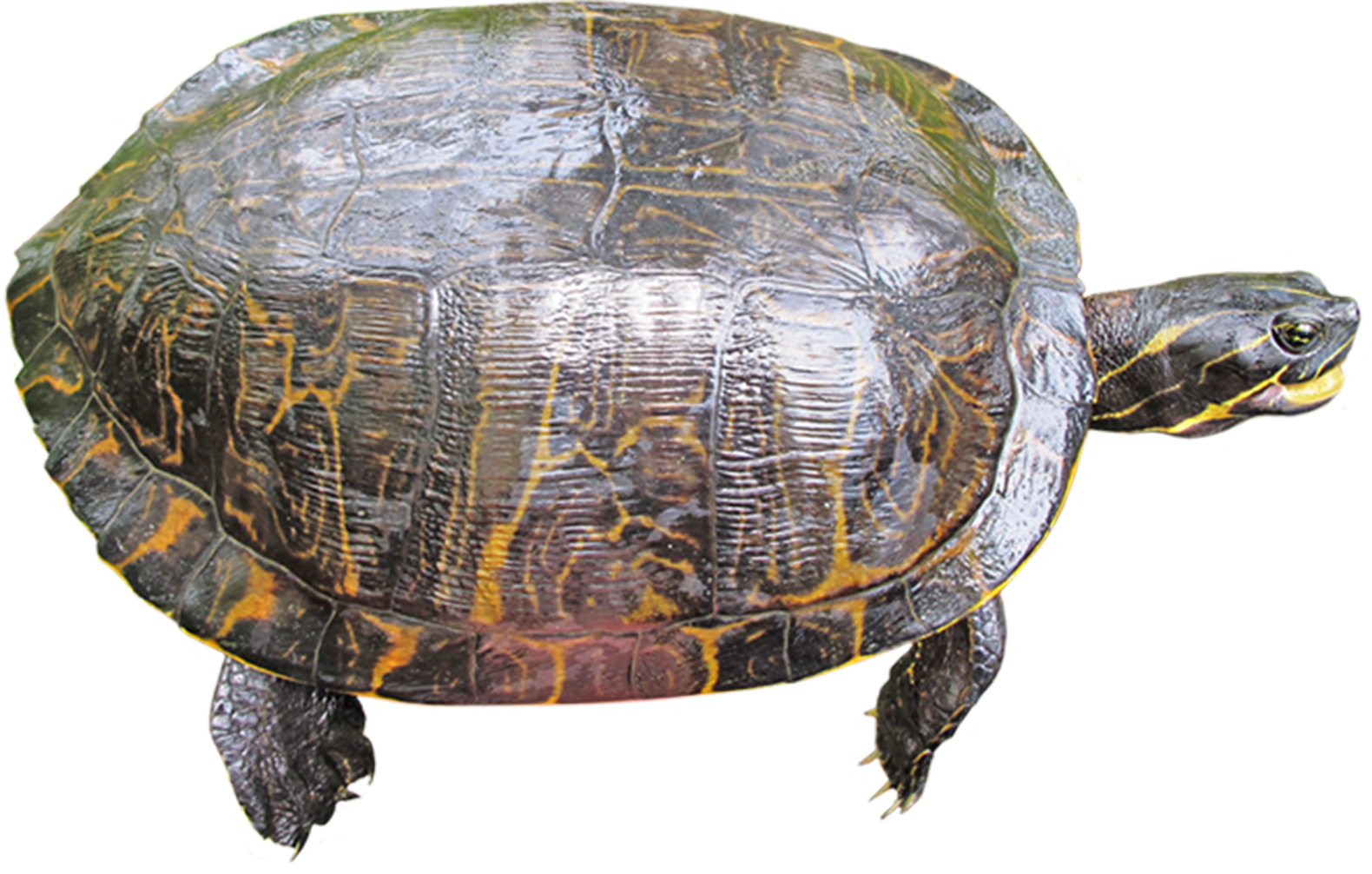
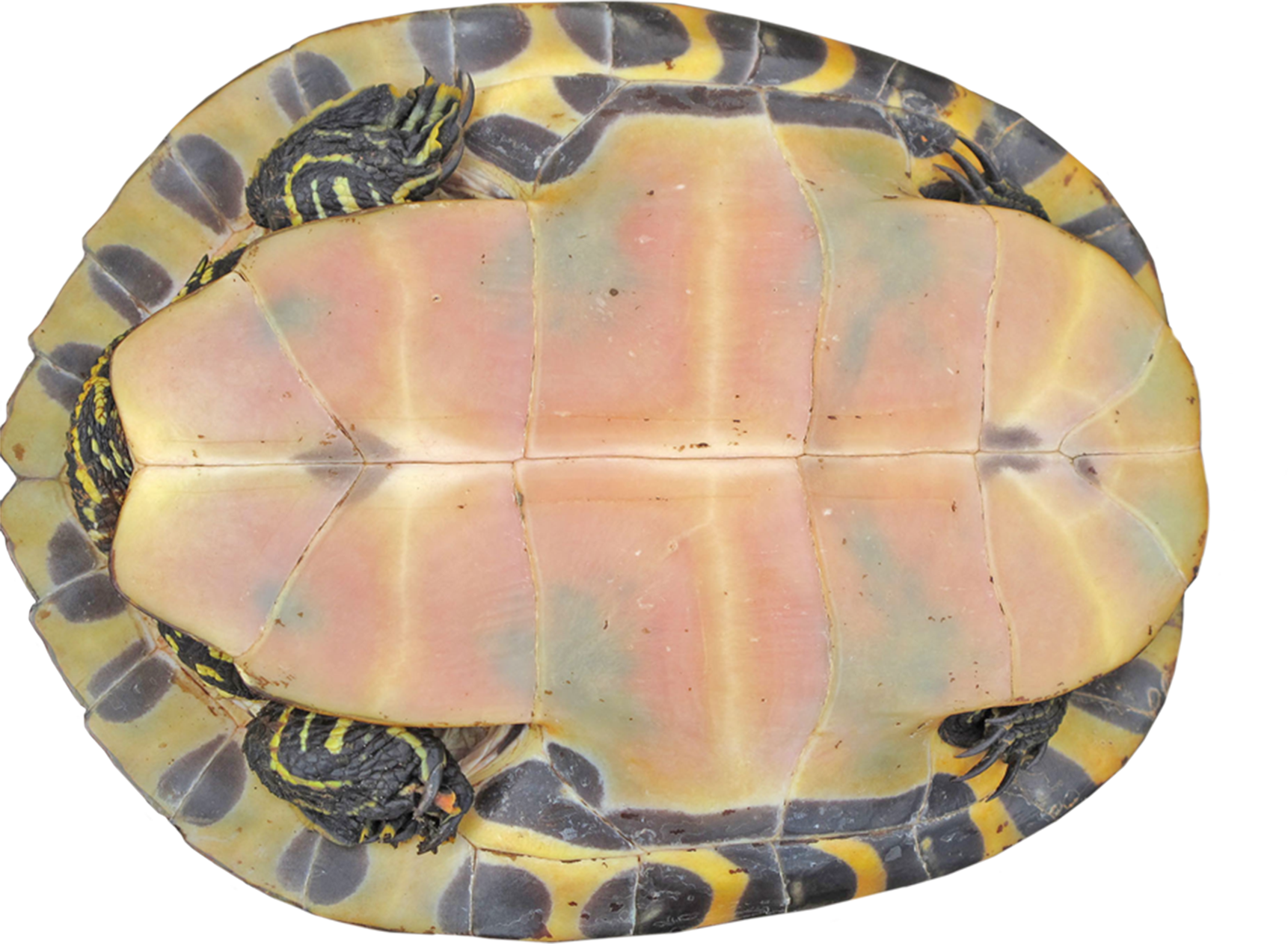
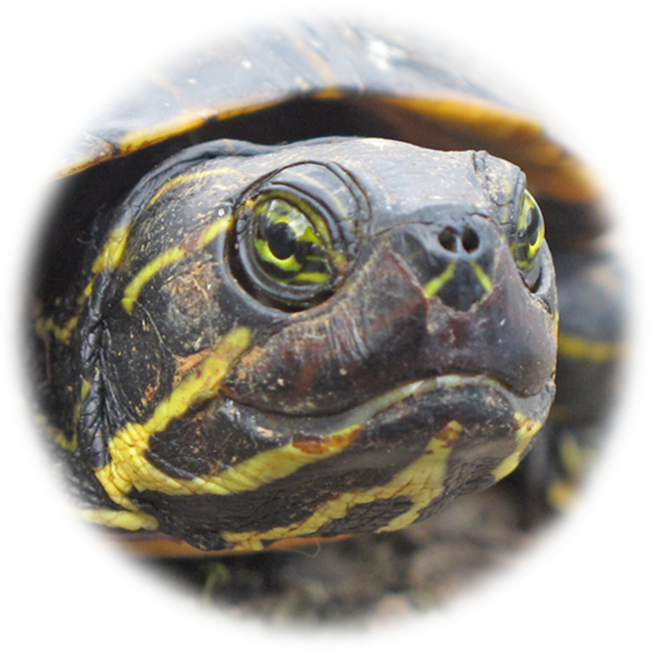
Native Pseudemys Face Comparisons
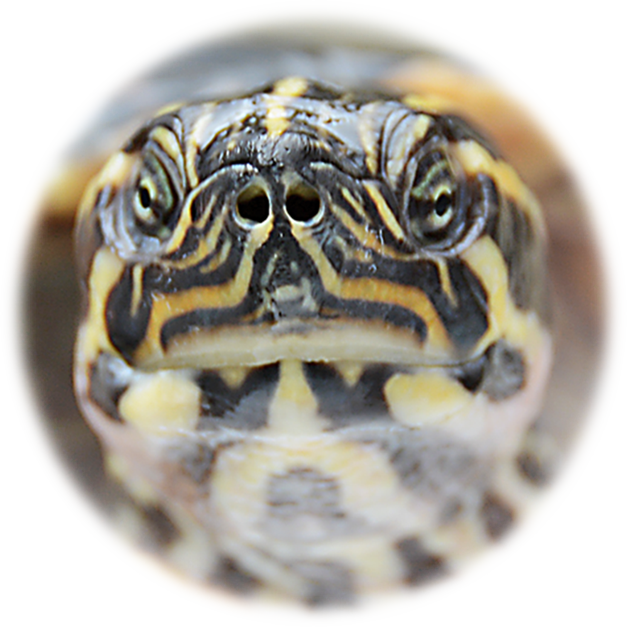 |
 |
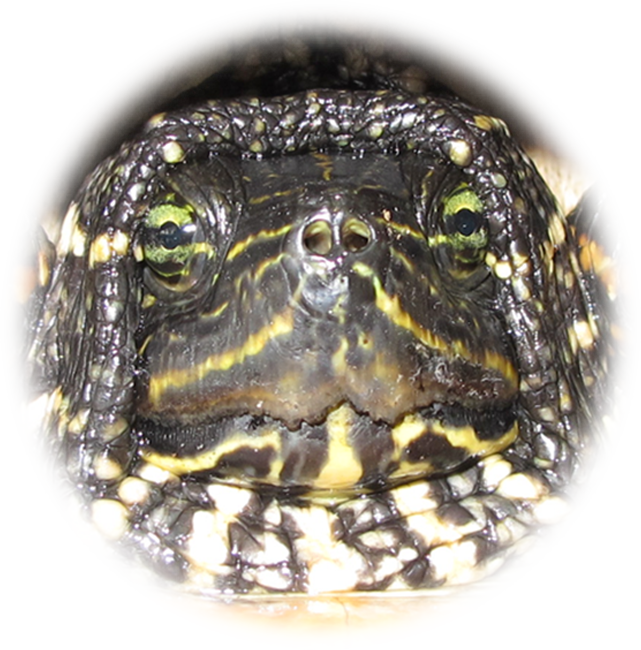 |
| Eastern River Cooter Pseudemys concinna concinna |
Coastal Plain Cooter Pseudemys concinna floridana |
Northern Red-bellied Cooter Pseudemys rubriventris |
Coloration and Pattern: Carapace brown to greenish brown with yellowish markings; a vertical yellowish stripe occurs in each pleural scute in most individuals; stripes may bifurcate at each end forming I- or X-shaped figures; 2 yellowish stripes forming an X pattern with the lines separated may appear on vertebrals 2-4; remaining carapacial pattern highly variable; dorsum of marginals with a transverse yellowish bar in the center; venter of marginals with a series of usually solid dark spots that are divided by seams of scutes; axillary and inguinal scutes on bridge may or may not have a dark spot; plastron yellowish without a pattern along seams of scutes; old individuals may develop brown mottling on plastron and carapace; skin brown to olive with yellowish stripes on head and limbs; dorsum of head with a short yellowish line that extends to tip of snout; chin and neck stripes wider than dorsal head stripes; upper neck stripe forks over upper and lower jaws, and chin stripes meet on throat to form a single line that ends at anterior apex of lower jaw; head stripes number <11; upper jaw lacks cusps and is not notched at midline.
Sexual Dimorphism: Females are larger than males (Gibbons and Lovich, 1990). Adult males from Virginia averaged 234.6 ± 27.1 mm CL (197.9-270.0, n = 5) and 211.6 ± 25.4 mm PL (179.8-247.0, n = 5). The smallest male weighed 841 g. A single adult female (CM 24447) from Isle of Wight County was 265 mm CL and 244 mm PL. Sexual dimorphism index was 0.13. In adult males, the foreclaws are elongated and the cloacal opening extends beyond the posterior margin of the carapace. Precloacal distance of the smallest male was 41 mm. Foreclaw length is unknown.
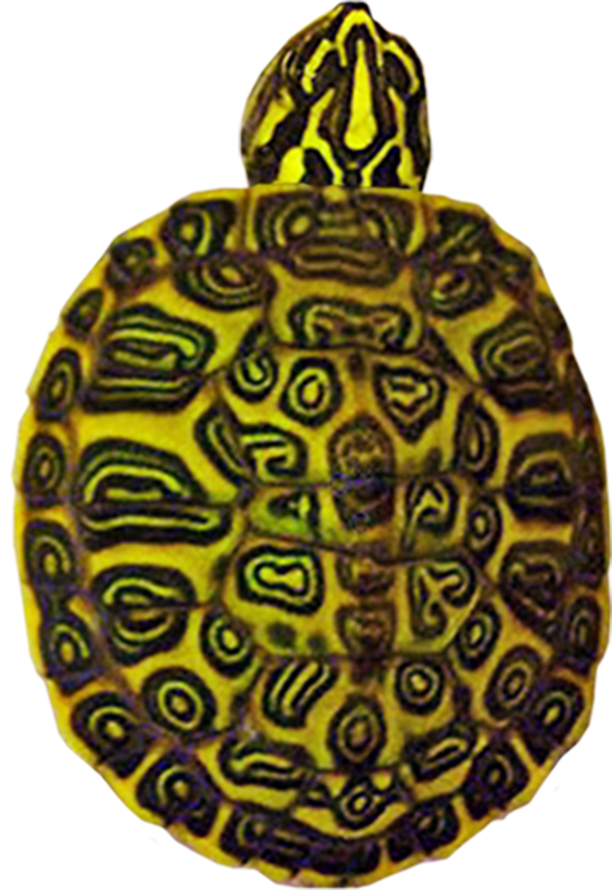
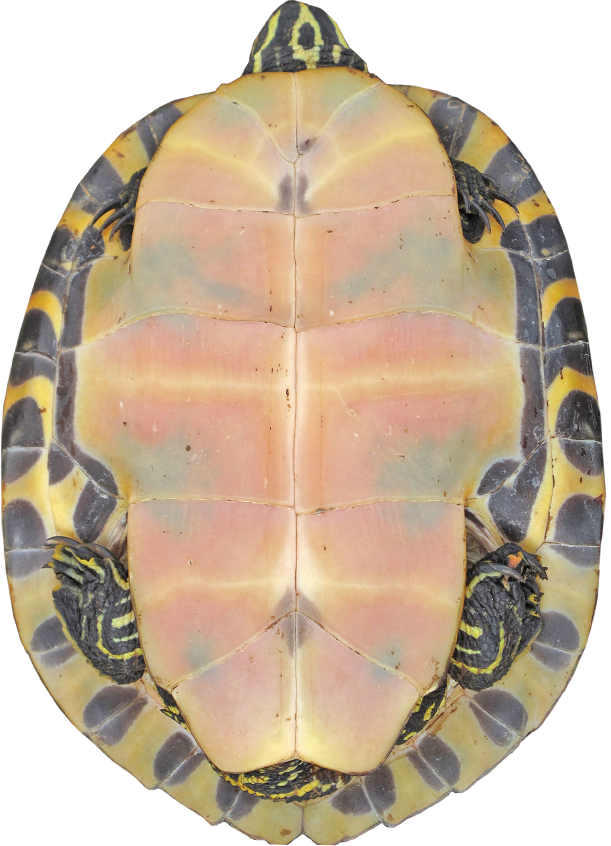
Juveniles: Juveniles have not been collected in Virginia. Hatchlings are brighter than adults, but with similar colors and patterns. The carapace is more highly arched than in adults and has a well-developed keel (Ernst and Barbour, 1972).
Confusing Species: This species may be easily confused with Pseudemys rubriventris, which has a reddish vertical stripe on the pleural scutes, a reddish plastron, a prominent cusp on each side of the notched upper jaw, and the lines forming an arrow shape on the dorsum of the snout. Pseudemys concinna is very similar but has a yellowish, reverse C-shaped marking on the 2d pleural scute, > 11 head and neck stripes, and a dark pattern along the plastral seams.
Geographic Variation: The patterns exhibited by Pseudemys concinna floridana are highly variable within and among populations. Geographic variation has not been examined in Virginia. In northeastern North Carolina, P. c. floridana populations show character convergence or hybridization with P. rubriventris, and along the Fall Line morphological characters are somewhat intermediate between P. c. floridana and P. concinna (Seidel and Palmer, 1991). Subspecific variation is based on differences in head pattern (Ernst and Barbour, 1989a).
Biology: In Virginia, the Coastal Plain Cooter inhabits slow-moving bodies of water, such as blackwater swamps, small lakes, and ponds. It has also been found in Lake Drummond. Preferred habitats include slow current, soft substrate, basking sites, and abundant aquatic vegetation (Ernst and Barbour, 1972). Seasonal activity is unknown in Virginia; all known specimens were caught in May through September. Coastal Plain Cooter are diurnal and are inactive at night (Ernst and Barbour, 1972). They frequently bask on logs and stumps. Terrestrial activity occurs for two primary reasons: nesting and moving from one body of water to another. Turtles inhabiting temporary aquatic habitats will quickly emigrate if total drying occurs from drought (Gibbons et al., 1983). As adults, Coastal Plain Cooter are predominately herbivorous, consuming a wide variety of aquatic plants (Ernst and Barbour, 1989a). Juveniles are carnivorous, probably preying on aquatic insects and insect larvae, but change to herbivory as they grow.
Nothing is known of the life history of P. c. floridana in Virginia. In South Carolina, females nested May through August, laid 5-18 eggs per clutch, and produced only one clutch per season (Gibbons et. al., 1982). Females reached maturity at ages of 6-7 years and PLs of 200-240 mm, whereas males reached maturity at about 3 years and 100-120 mm PL (Gibbons and Coker, 1977). The smallest known Coastal Plain Cooter from Virginia was a 4-year-old, apparently immature male measuring 139.9 mm PL. In northern Florida, Jackson (1988) observed nesting in all months except February, July, August, and September; clutch sizes of 10-23 eggs; and a clutch frequency of three to six. Ernst and Barbour (1989a) reported clutch sizes of 8-29, egg sizes of 29-40 x 22-27 mm, and incubation periods of 70-100 days. Hatchlings overwinter in the nest in South Carolina and enter aquatic habitats the following spring (Gibbons and Coker, 1977).
Little information has been published on the population ecology of this species. Immature Coastal Plain Cooter in South Carolina grew at rates of 20-40 mm annually, whereas adults grew at rates of 0-18 mm annually (Gibbons and Coker, 1977). Population densities were 4.6-7.0 per hectare and biomass was 0.9-7.8 kg per hectare in two South Carolina ponds (Congdon et al., 1986).
Remarks: Pseudemys concinna floridana is morphologically similar to P. concinna in Atlantic slope drainages, so much so that diagnostic characters that separate these species elsewhere in their range are of little value in this region (Seidel and Palmer, 1991). The taxonomic relationship of these two species is still under study. Results could include maintaining recognition of these turtles as separate species or placing Atlantic slope populations of P. florida in synonymy with P. concinna (M. E. Seidel, pers. comm.).
No populations of Pseudemys concinna floridana are known to occur in microsympatry with P. concinna in Virginia. Coastal Plain Cooter do, however, coexist with P. rubriventris in the state, and with River Cooters elsewhere in their range.
Conservation and Management: Because this species has only been recently confirmed in Virginia (Seidel and Palmer, 1991), its population status cannot be ascertained. The amount of trapping conducted in southeastern Virginia suggests that Coastal Plain Cooter are either not abundant or are not readily captured. Obviously, additional inventories and studies of their life history need to be conducted. Until definitive data are available, Coastal Plain Cooter should be listed as status undetermined in Virginia.
References for Life History
Photos:
*Click on a thumbnail for a larger version.
Verified County/City Occurrence in Virginia
Isle of Wight
Southampton
Sussex
CITIES
Chesapeake
Franklin
Norfolk
Suffolk
Verified in 3 counties and 4 cities.
U.S. Range
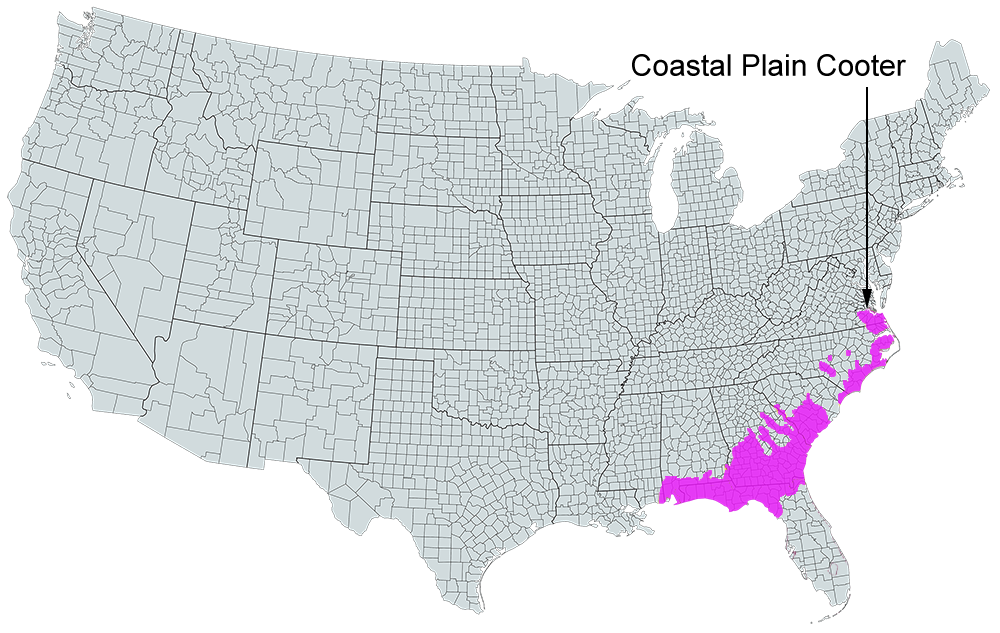



0001-sm.jpg)
0002-sm.jpg)




